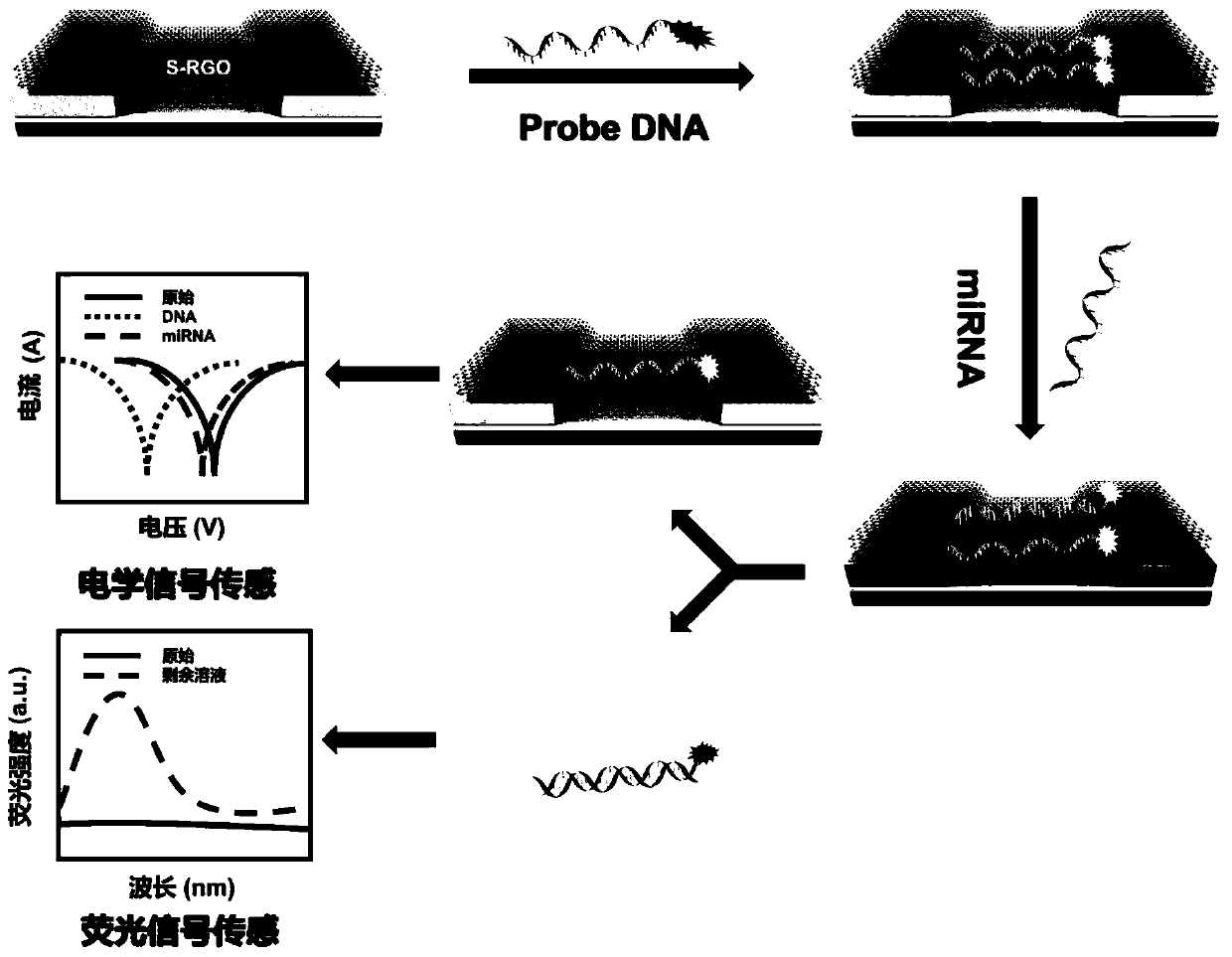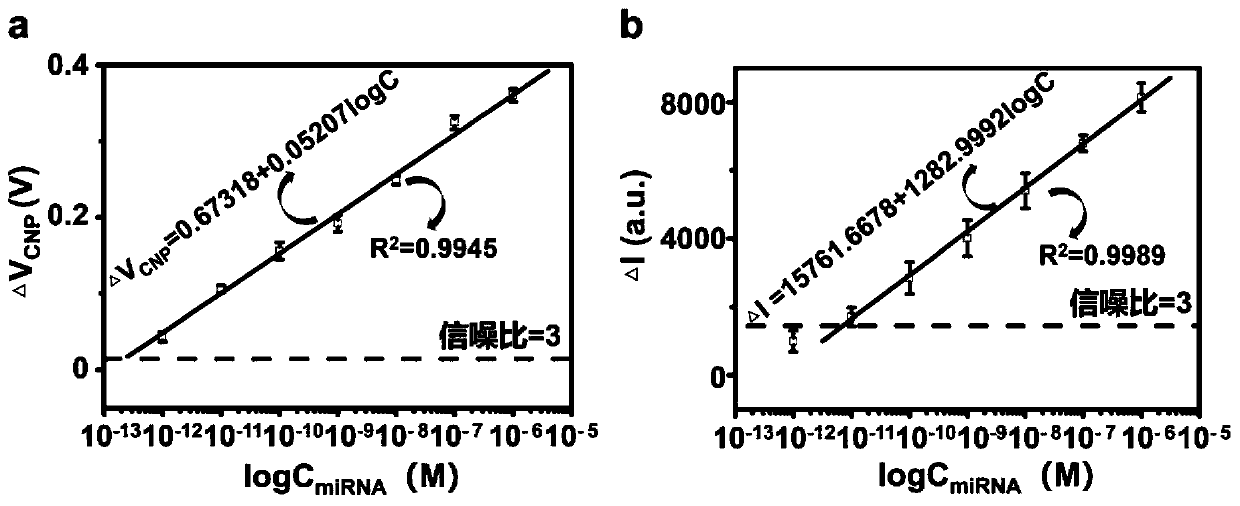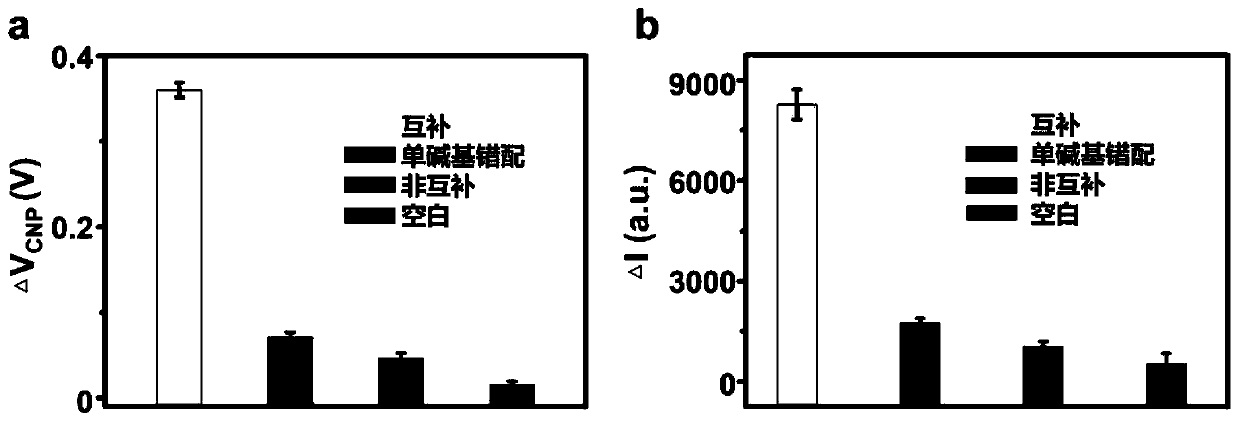Self-calibration double-signal biosensor and application thereof in miRNA detection
A biosensor and dual-signal technology, applied in the field of biosensors, can solve problems such as poor sensitivity and specificity, complicated operation, etc., and achieve the effects of reducing false positives, improving reliability, and realizing self-calibration functions
- Summary
- Abstract
- Description
- Claims
- Application Information
AI Technical Summary
Problems solved by technology
Method used
Image
Examples
Embodiment 1
[0049] Example 1: Preparation of self-calibrating dual-signal biosensor
[0050] (1) Clean the SiO with deionized water and isopropanol in sequence 2 oxide layer of the silicon wafer. Next, put them in piranha solution (H 2 SO 4 :H 2 o 2 =7:3) at 100°C for 8 minutes for hydroxylation.
[0051] (2) Immerse the hydroxylated silicon wafer in 3-aminopropyltrimethylsilane (APTMS) solution (ethanol:water=95:5, APTMS 2vol%) for 30 minutes, rinse and perform three times in Mill-Q water for 10 min sonication followed by N 2 Dry in medium to obtain aminated substrates. The aminated substrate was immersed in graphene oxide (GO) aqueous solution (0.1 mg / ml) for 45 min, after which the samples were rinsed and sonicated three times for 15 min in Mill-Q water and washed with N 2 Dry to obtain a bilayer (APTMS / GO) membrane. By repeating the above steps 5 times, covalently assembled (APTMS / GO) 5 film, where 5 represents the number of layers of the bilayer (APTMS / GO) film, and the thi...
Embodiment 2
[0054] Example 2: Performance investigation of self-calibrating dual-signal biosensor for detecting miRNA
[0055] 1. Linear curve and sensitivity:
[0056] (1) Prepare a self-calibrating dual-signal biosensor with Example 1, test the transfer curve of a self-calibrating dual-signal biosensor and obtain the grid voltage value D of the Dirac point 1 ;
[0057] (2) Soak the self-calibrating dual-signal biosensor in 600 μL of complementary miRNA (5'-UAA CAC UGU CUG GUA AAG AUG G-3') solution at different concentrations, and incubate at room temperature for 20 min, and then use Rinse with DEPC water to remove excess miRNA sequences, and dry at room temperature at 20°C for at least 2 seconds to test the transfer curve of the above self-calibration dual-signal biosensor and obtain the gate voltage value D of the Dirac point 2 ;
[0058] The solvent of the miRNA solution is DEPC water, and an RNase inhibitor is added during preparation, so that the final concentration of the RNase...
Embodiment 3
[0075] Example 3: Serum Sample Analysis
[0076] (1) Prepare a self-calibrating dual-signal biosensor with Example 1, test a transfer curve of a self-calibrating dual-signal biosensor and obtain the grid voltage value D of the Dirac point 1 ;
[0077] (2) Dilute fetal bovine serum 20 times with DEPC water and add 6×10 –10 M complementary miRNA (5'-UAACAC UGU CUG GUA AAG AUG G-3') to prepare miRNA test solution.
[0078] When preparing the miRNA test solution, RNase inhibitors were added so that the final concentration of RNase inhibitors was 10 μM.
[0079] (3) Soak the self-calibrating dual-signal biosensor in 600 μL of miRNA test solution and incubate for 20 minutes, then rinse with DEPC water to remove excess miRNA sequences, and dry at room temperature at 20°C for at least 2 seconds to test the performance of the above FET Transfer the curve and get the grid voltage value D at the Dirac point 2 ;
[0080] Before soaking the self-calibrating dual-signal sensor in the m...
PUM
| Property | Measurement | Unit |
|---|---|---|
| thickness | aaaaa | aaaaa |
Abstract
Description
Claims
Application Information
 Login to View More
Login to View More - R&D
- Intellectual Property
- Life Sciences
- Materials
- Tech Scout
- Unparalleled Data Quality
- Higher Quality Content
- 60% Fewer Hallucinations
Browse by: Latest US Patents, China's latest patents, Technical Efficacy Thesaurus, Application Domain, Technology Topic, Popular Technical Reports.
© 2025 PatSnap. All rights reserved.Legal|Privacy policy|Modern Slavery Act Transparency Statement|Sitemap|About US| Contact US: help@patsnap.com



